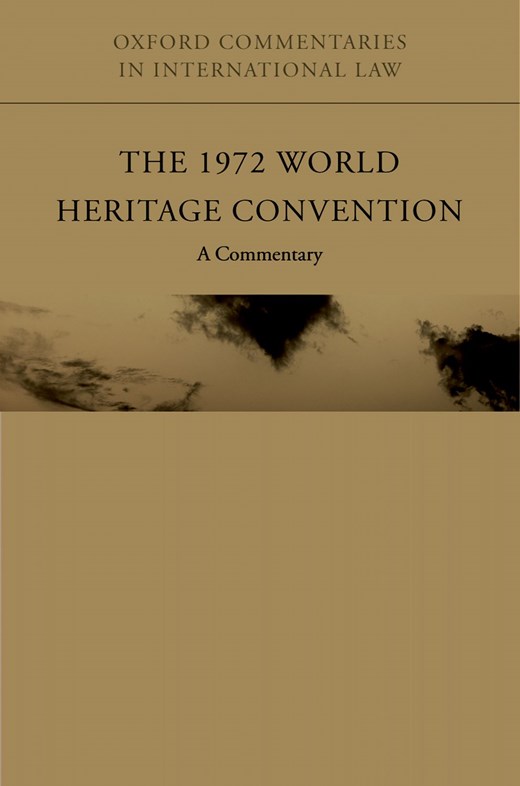 The 1972 World Heritage Convention: A Commentary (1)
The 1972 World Heritage Convention: A Commentary (1)
Contents
-
-
-
-
-
-
-
-
The 1972 World Heritage Convention in the Framework of Other UNESCO Conventions on Cultural Heritage
-
-
-
-
-
I. Introduction I. Introduction
-
II. Problems and Gaps II. Problems and Gaps
-
III. The World Heritage Convention in the Twenty-First Century: Which Perspectives? III. The World Heritage Convention in the Twenty-First Century: Which Perspectives?
-
-
-
-
The Future of the World Heritage Convention: Problems and Prospects
Get access-
Published:March 2008
Cite
Extract
Introduction
In the 35 years since its adoption, the 1972 World Heritage Convention has proven to be a successful and effective instrument for the protection of cultural property and of natural environment of exceptional interest for humanity. The steady increase in the number of contracting Parties (185 at 30 August 2007)1 and of properties inscribed on the World Heritage List (851 after the 31st Session of the World Heritage Committee, held in Christchurch, New Zealand, from 23 June to 2 July 2007)2 bears witness to this success. This is certainly due in part to the great visibility of the system created by the Convention, which is well known by people all over the world, if not always in its technical legal aspects. This is a rare feature for an international convention, since only a very few multilateral treaties, as eg, the UN Convention on the Rights of the Child,3 the CITES Convention4 and, to a more limited extent, the Antarctic Treaty,5 possess the capacity of projecting their effects beyond the sphere of governmental obligations to become part of the civil society and of the everyday life of people. In nearly all countries of the world, people, even when they ignore the contents and details of the Convention as an international legal instrument, consider every property inscribed on the World Heritage List (the List), and accompanied by the distinctive emblem of the Convention, as the ‘heritage of humanity’ tout court. This recognition goes beyond the ‘legal’ consideration of the Convention as a treaty, whose effects are limited only to States Parties, and it is not diminished by the fact that each property inscribed on the List remains subject to the sovereignty of the state in whose territory it is located.
Sign in
Personal account
- Sign in with email/username & password
- Get email alerts
- Save searches
- Purchase content
- Activate your purchase/trial code
- Add your ORCID iD
Purchase
Our books are available by subscription or purchase to libraries and institutions.
Purchasing information| Month: | Total Views: |
|---|---|
| September 2024 | 1 |
| October 2024 | 2 |
| November 2024 | 5 |
| January 2025 | 1 |
| April 2025 | 1 |



Get help with access
Institutional access
Access to content on Oxford Academic is often provided through institutional subscriptions and purchases. If you are a member of an institution with an active account, you may be able to access content in one of the following ways:
IP based access
Typically, access is provided across an institutional network to a range of IP addresses. This authentication occurs automatically, and it is not possible to sign out of an IP authenticated account.
Sign in through your institution
Choose this option to get remote access when outside your institution. Shibboleth/Open Athens technology is used to provide single sign-on between your institution’s website and Oxford Academic.
If your institution is not listed or you cannot sign in to your institution’s website, please contact your librarian or administrator.
Sign in with a library card
Enter your library card number to sign in. If you cannot sign in, please contact your librarian.
Society Members
Society member access to a journal is achieved in one of the following ways:
Sign in through society site
Many societies offer single sign-on between the society website and Oxford Academic. If you see ‘Sign in through society site’ in the sign in pane within a journal:
If you do not have a society account or have forgotten your username or password, please contact your society.
Sign in using a personal account
Some societies use Oxford Academic personal accounts to provide access to their members. See below.
Personal account
A personal account can be used to get email alerts, save searches, purchase content, and activate subscriptions.
Some societies use Oxford Academic personal accounts to provide access to their members.
Viewing your signed in accounts
Click the account icon in the top right to:
Signed in but can't access content
Oxford Academic is home to a wide variety of products. The institutional subscription may not cover the content that you are trying to access. If you believe you should have access to that content, please contact your librarian.
Institutional account management
For librarians and administrators, your personal account also provides access to institutional account management. Here you will find options to view and activate subscriptions, manage institutional settings and access options, access usage statistics, and more.